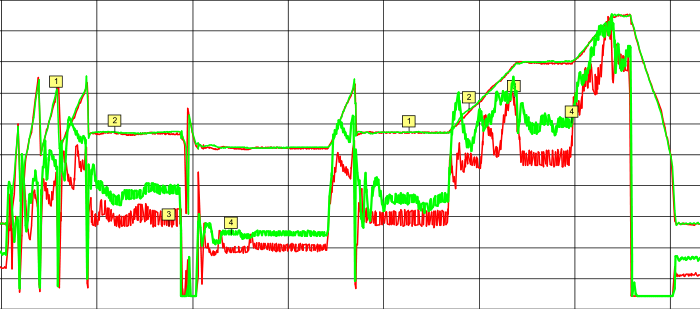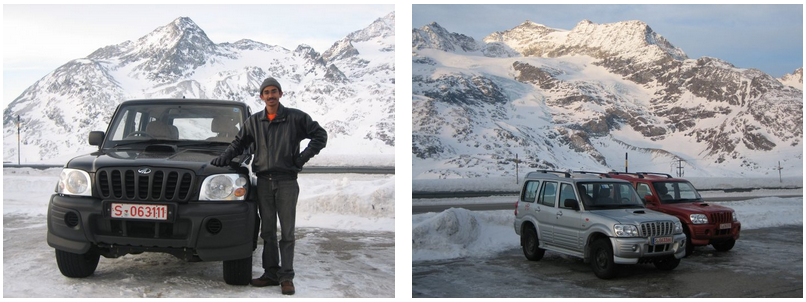From August 2003 to August 2007, I worked with Research & Development at Mahindra & Mahindra’s Automotive Sector. M&M is one of India’s largest automotive companies.

I was part of a team developing M&M’s flagship product at the time, a Sports Utility Vehicle called the Mahindra Scorpio. My tasks involved
- Combustion development of the common rail diesel engine, so that the vehicle emissions complied to the Euro IV standard
- Creating a tool for programming the electronic engine controller at the vehicle assembly line
- Creating a hand-held test tool for diagnosing faults within the engine management (and later anti-lock brake) systems
Euro IV combustion development
The Mahindra Scorpio was a phenomenal success in India. Beyond India, M&M had a small presence in select European markets where it wished to introduce the Scorpio. To meet the requirements of the European market, the Scorpio’s engine had to be upgraded to Euro IV emission standards.

I was part of a small team responsible for delivering a Euro IV compliant vehicle. My role involved combustion engineering and emissions development. It started off with a downsized version of the Scorpio’s engine for the Indian market. The downsized engine was upgraded with a common rail diesel injection system and the combustion was tuned to meet the desired power and torque requirements. Later, the engine was mounted on the vehicle and then began a phase of intense emissions engineering. Over a period of many months, the combustion processes were tuned so that the pollutant quantities in the vehicle exhaust fell below the Euro IV target requirements.

Once the emissions targets were met, the combustion processes had to be calibrated for extreme cold conditions and high altitudes. To do this, I spent time with the cars in the Swiss Alps in winter and the Sierra Nevada mountains, Spain, in summer.
A paper outlining our strategy to meet the Euro IV emission norms was published at the SAE World Congress, 2007.
By the time I left the company in August 2007, the Scorpio’s European version was Euro IV emissions certified and being readied for launch.
ECU programming at vehicle assembly line
In 2004, the Mahindra Scorpio’s engine was upgraded to a common rail diesel system, together with an electronic engine controller. This was the first time an electronically controlled engine would be launched in a Mahindra automobile. The electronic control unit (ECU) needed to be programmed with the correct software version at the vehicle assembly line. Furthermore, the programmed software version had to be calibrated with parameters specific to the particular engine mounted in each vehicle.
The ECU programming procedure needed to
- Finish within 3 minutes. Any delays implied the entire assembly line being held up.
- Be extremely robust and tamper resistant. Any breakdown in the procedure/equipment implied loss of daily production targets.
An additional challenge was the fact that the calibration data specific to each engine could only be generated at the engine manufacturing plant, which was situated in another city. This calibration data had to be instantly available while the ECU was being programmed at the vehicle assembly line.

I developed complete software+hardware solutions for
- Generating calibration data at the engine manufacturing plant
- Storing and communicating this data to the vehicle assembly plant
- Programming vehicle ECUs at the assembly line with correct software versions and calibration information
The system met all requirements and was used in daily vehicle production for several years. It won the company’s Best Process Innovation award, which recognizes business driven innovation.
The system was still in use when I left the company in August 2007.
Diagnostic test tool
Modern automobiles contain many Electronic Control Units (ECUs) that control the various subsystems within the automobile, like engine, brakes, transmission etc. These ECUs are capable of detecting many different kinds of faults within the system (for example, short circuits, sensor malfunctions). When a vehicle is being serviced, it is a common practice to connect to the vehicle ECUs and read the current (and past) faults as well as tune various parameters, for example the engine’s idling speed. To make the connection, some form of hand-held computer or laptop running specialized software is utilized.
My tasks were to
- Formulate the communication protocols for communicating with the engine ECU
- Develop the necessary computer hardware, software and interfacing electronics for communicating with the engine ECU
- Develop a software application which would be used by service engineers and mechanics to diagnose and eliminate ECU faults

I developed an end-to-end solution named Mahindra Insight, which met all requirements. Insight was deployed to company workshops across the country and remained in use for several years. An year later, I extended Insight to diagnose faults within the Anti-Lock Brake (ABS) system which was under development.
Insight won the company’s Best Product Innovation award, which recognizes business driven innovation.
Eventually, the company decided to stop in-house development and Insight was replaced by a laptop based solution developed by a third party contractor.